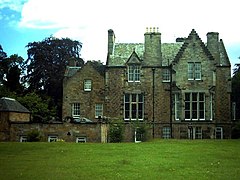Lasswade
| Lasswade | |
|---|---|
 Pittendreich House, Lasswade by David Bryce |
|
| Lasswade shown within Midlothian | |
| OS grid reference | NT301661 |
| Council area | |
| Lieutenancy area | |
| Country | Scotland |
| Sovereign state | United Kingdom |
| Post town | LASSWADE |
| Postcode district | EH18 |
| Dialling code | 0131 |
| Police | Scottish |
| Fire | Scottish |
| Ambulance | Scottish |
| EU Parliament | Scotland |
| UK Parliament | |
| Scottish Parliament | |
Lasswade is a village and parish in Midlothian, Scotland, on the River North Esk, nine miles (14.5 kilometres) south of Edinburgh city centre, between Dalkeith and Loanhead. Melville Castle lies to the north east.
Lasswade lies within the Edinburgh Green Belt. Most of the population is retired or commutes to Edinburgh to work. There are, however, several local businesses, including horse riding stables (Edinburgh & Lasswade Riding Centre), a golf driving range and golf course (Melville Golf Centre), an alpine plant nursery (Kevock Garden Plants) and a pub (The Laird and Dog), and there is also an athletics club, Lasswade Athletics Club, formed in 1981.
The name Lasswade probably derives from the Old English for læs - meaning meadow and (ge)wæd - meaning ford.
Although the settlement may date back to the 8th century the first written record of "Leswade" dates to 1150. On William Roy's map of 1750 it appears as Laswaid. Up until the late 18th century all spelling was unfixed and was based upon the sound as perceived.
The old parish church was built in the 13th century, though little of it today survives. It was abandoned in 1793 and much of its ruins collapsed in 1866. The 17th century Scottish poet, William Drummond of Hawthornden was buried within its grounds.
Sir John Lauder, 1st Baronet of Fountainhall was born at Melville Mill, Lasswade, in 1595, and the present 18th-century Barony House was known as Lasswade Cottage when Sir Walter Scott rented it (1798-1804). He was visited here by the writer James Hogg (the 'Ettrick Shepherd') and the Wordsworths. Thomas de Quincey, author of Confessions of an English Opium Eater, also lived in nearby Polton for some years from 1843, in the cottage now known as de Quincey Cottage. The Scottish landscape artist William McTaggart moved to Lasswade in 1889, and many of his later works depict the Moorfoot Hills.
...
Wikipedia

